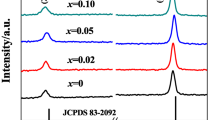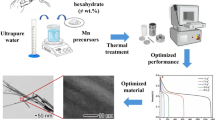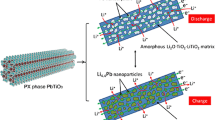Abstract
Using a model tunnel manganese oxide with the todorokite crystal structure (T-MnO2), we demonstrate that controlling the morphology of the active material can improve the cycling stability of intercalation battery electrodes. The T-MnO2 structure is built from tunnels that provide spacious 1D diffusion channels for charge-carrying ions. Taking advantage of the unique ability to synthesize T-MnO2 in the form of both highly crystalline two-dimensional (2D) nanoplatelets and one-dimensional (1D) nanowires through a facile hydrothermal growth method, we investigated the effect of nanoscale particle dimensions on reversible battery cycling. Insertion of ions into the tunnels results in anisotropic expansion of the structure, making T-MnO2 with different morphologies an excellent model platform to understand how intercalation-induced volume change, typically leading to the deterioration of the electrode performance over extended cycling, can be controlled through synthesis of targeted morphologies. T-MnO2 nanowires showed not only significantly improved capacity retention but also substantially higher specific capacity than the T-MnO2 nanoplatelets. The enhanced electrochemical properties of the nanowire electrodes could be attributed to the larger surface-to-volume ratio than that of nanoplatelets, resulting in higher contact area with electrolyte for the nanowires. Moreover, due to the smaller cross-sectional area of the nanowires, volume expansion and contraction perpendicular to the structural tunnels induced by reversible ion intercalation occurs in a more facile fashion. This work shows that chemically controlling morphology and producing particles with nanostructure dimensionality replicating that of atomic structure (i.e., 1D morphology and 1D structure) makes it possible to enhance material performance.

ᅟ






Similar content being viewed by others
References
Chan CK, Peng H, Liu G, McIlwrath K, Zhang XF, Huggins RA, Cui Y (2008) High-performance lithium battery anodes using silicon nanowires. Nat Nanotechnol 3(1):31–35
Mai L, Tian X, Xu X, Chang L, Xu L (2014) Nanowire electrodes for electrochemical energy storage devices. Chem Rev 114(23):11828–11862
Wei Q, Xiong F, Tan S, Huang L, Lan EH, Dunn B, Mai L (2017) Porous one-dimensional nanomaterials: design, fabrication and applications in electrochemical energy storage. Adv Mater 29(20):1–39
Chan CK, Zhang XF, Cui Y (2008) High capacity Li ion battery anodes using Ge nanowires. Nano Lett 8(1):307–309
Kim H, Cho J (2008) Hard templating synthesis of mesoporous and nanowire SnO 2 lithium battery anode materials. J Mater Chem 18(7):771–775
Kim S-W, Lee H-W, Muralidharan P, Seo D-H, Yoon W-S, Kim DK, Kang K (2011) Electrochemical performance and ex situ analysis of ZnMn2O4 nanowires as anode materials for lithium rechargeable batteries. Nano Res 4(5):505–510
Li Y, Tan B, Wu Y (2008) Mesoporous Co3O4 nanowire arrays for lithium ion batteries with high capacity and rate capability. Nano Lett 8(1):265–270
Teh PF, Sharma Y, Ko YW, Pramana SS, Srinivasan M (2013) Tuning the morphology of ZnMn2O 4 lithium ion battery anodes by electrospinning and its effect on electrochemical performance. RSC Adv 3(8):2812–2821
Li X, Cheng F, Guo B, Chen J (2005) Template-synthesized LiCoO2, LiMn2O4, and LiNi0. 8Co0.2O2 nanotubes as the cathode materials of lithium ion batteries. J Phys Chem B 109(29):14017–14024
Yan W, Ayvazian T, Kim J, Liu Y, Donavan KC, Xing W, Yang Y, Hemminger JC, Penner RM (2011) Mesoporous manganese oxide nanowires for high-capacity, high-rate, hybrid electrical energy storage. ACS Nano 5(10):8275–8287
Yan W, Thai ML, Dutta R, Li X, Xing W, Penner RM (2014) A lithographically patterned capacitor with horizontal nanowires of length 2.5 mm. ACS Appl Mater Interfaces 6(7):5018–5025
Hosono E, Kudo T, Honma I, Matsuda H, Zhou H (2009) Synthesis of single crystalline spinel LiMn2O4 nanowires for a lithium ion battery with high power density. Nano Lett 9(3):1045–1051
Lee H-W, Muralidharan P, Ruffo R, Mari CM, Cui Y, Kim DK (2010) Ultrathin spinel LiMn2O4 nanowires as high power cathode materials for Li-ion batteries. Nano Lett 10(10):3852–3856
Zhu C, Yu Y, Gu L, Weichert K, Maier J (2011) Electrospinning of highly electroactive carbon-coated single-crystalline LiFePO4 nanowires. Angew Chem Int Ed 50(28):6278–6282
Byles B, West P, Cullen DA, More KL, Pomerantseva E (2015) Todorokite-type manganese oxide nanowires as an intercalation cathode for Li-ion and Na-ion batteries. RSC Adv 5(128):106265–106271
Byles BW, Palapati NKR, Subramanian A, Pomerantseva E (2016) The role of electronic and ionic conductivities in the rate performance of tunnel structured manganese oxides in Li-ion batteries. APL Mater 4(4):046108
Duncan MJ, Leroux F, Corbett JM, Nazar LF (1998) Todorokite as a Li insertion cathode: comparison of a large tunnel framework MnO2 structure with its related layered structures. J Electrochem Soc 145(11):3746–3757
Kumagai N, Komaba S, Abe K, Yashiro H (2005) Synthesis of metal-doped todorokite-type MnO2 and its cathode characteristics for rechargeable lithium batteries. J Power Sources 146(1–2):310–314
Kumagai N, Komaba S, Sakai H, Kumagai N (2001) Preparation of todorokite-type manganese-based oxide and its application as lithium and magnesium rechargeable battery cathode. J Power Sources 97–98:515–517
Bodeï S, Manceau A, Geoffroy N, Baronnet A, Buatier M (2007) Formation of todorokite from vernadite in Ni-rich hemipelagic sediments. Geochim Cosmochim Acta 71(23):5698–5716
Feng XH, Tan WF, Liu F, Wang JB, Ruan HD (2004) Synthesis of todorokite at atmospheric pressure. Chem Mater 16(22):4330–4336
Hu X, Kitchaev DA, Wu L, Zhang B, Meng Q, Poyraz AS, Marschilok AC, Takeuchi ES, Takeuchi KJ, Ceder G (2018) Revealing and rationalizing the rich polytypism of todorokite MnO2. J Am Chem Soc 140:6961–6968. https://doi.org/10.1021/jacs.8b02971
Feng Q, Kanoh H, Miyai Y, Ooi K (1995) Metal ion extraction/insertion reactions with todorokite-type manganese oxide in the aqueous phase. Chem Mater 7(9):1722–1727
Atkins AL, Shaw S, Peacock CL (2014) Nucleation and growth of todorokite from birnessite: implications for trace-metal cycling in marine sediments. Geochim Cosmochim Acta 144:109–125
Byles BW, Cullen DA, More KL, Pomerantseva E (2018) Tunnel structured manganese oxide nanowires as redox active electrodes for hybrid capacitive deionization. Nano Energy 44:476–488
Al-Sagheer FA, Zaki MI (2004) Synthesis and surface characterization of todorokite-type microporous manganese oxides: implications for shape-selective oxidation catalysts. Microporous Mesoporous Mater 67(1):43–52
Lee J, Ju JB, Cho WI, Cho BW, Oh SH (2013) Todorokite-type MnO2 as a zinc-ion intercalating material. Electrochim Acta 112:138–143
Shen Y-F, Suib SL, O'Young C-L (1994) Effects of inorganic cation templates on octahedral molecular sieves of manganese oxide. J Am Chem Soc 116(24):11020–11029
Sun Z, Chen H, Shu D, He C, Tang S, Zhang J (2012) Supercapacitive behavior and high cycle stability of todorokite-type manganese oxide with large tunnels. J Power Sources 203:233–242
Yuan Y, Byles B, Liu C, Song B, Amine K, Pomerantseva E, Shahbazian-Yassar R, Lu J (2018) Deciphering The Atomic Patterns Leading To MnO2 Polymorphism. Adv Mater (under review)
Cui H-J, Shi J-W, Liu F, Fu M-L (2011) Large-scale preparation of hierarchical manganese oxide octahedral molecular sieves (OMS-1) composed of nanoplate microspheres via a facile one-pot reflux method. J Mater Chem 21(46):18527–18529
Yang Y, Shu D, Yu H, Xia X, Lin ZG (1997) Investigations of lithium manganese oxide materials for lithium-ion batteries. J Power Sources 65(1):227–230
Shen XF, Ding YS, Liu J, Cai J, Laubernds K, Zerger RP, Vasiliev A, Aindow M, Suib SL (2005) Control of nanometer-scale tunnel sizes of porous manganese oxide octahedral molecular sieve nanomaterials. Adv Mater 17(7):805–809
Clites M, Hart JL, Taheri ML, Pomerantseva E (2018) Chemically preintercalated bilayered KxV2O5·nH2O nanobelts as a high-performing cathode material for K-ion batteries. ACS Energy Letters 3(3):562–567
Xu F, Wu L, Meng Q, Kaltak M, Huang J, Durham JL, Fernandez-Serra M, Sun L, Marschilok AC, Takeuchi ES (2017) Visualization of lithium-ion transport and phase evolution within and between manganese oxide nanorods. Nat Commun 8:1–8
Yuan Y, Amine K, Lu J, Shahbazian-Yassar R (2017) Understanding materials challenges for rechargeable ion batteries with in situ transmission electron microscopy. Nat Commun 8:1–14
Yuan Y, Ma L, He K, Yao W, Nie A, Bi X, Amine K, Wu T, Lu J, Shahbazian-Yassr R (2016) Dynamic study of (De) sodiation in alpha-MnO 2 nanowires. Nano Energy 19:382–390
Yuan Y, Nie A, Odegard GM, Xu R, Zhou D, Santhanagopalan S, He K, Asayesh-Ardakani H, Meng DD, Klie RF (2015) Asynchronous crystal cell expansion during lithiation of K+-stabilized α-MnO2. Nano Lett 15(5):2998–3007
Lee SY, Wu L, Poyraz AS, Huang J, Marschilok AC, Takeuchi KJ, Takeuchi ES, Kim M, Zhu Y (2017) Lithiation mechanism of tunnel-structured MnO2 electrode investigated by in situ transmission electron microscopy. Adv Mater 29(43):1703186
Yuan Y, Zhan C, He K, Chen H, Yao W, Sharifi-Asl S, Song B, Yang Z, Nie A, Luo X (2016) The influence of large cations on the electrochemical properties of tunnel-structured metal oxides. Nat Commun 7:13374
Maksud M, Palapati N, Byles B, Pomerantseva E, Liu Y, Subramanian A (2015) Dependence of Young’s modulus on the sodium content within the structural tunnels of a one-dimensional Na-ion battery cathode. Nanoscale 7(42):17642–17648
Palapati N, Pomerantseva E, Subramanian A (2015) Single nanowire manipulation within dielectrophoretic force fields in the sub-crossover frequency regime. Nanoscale 7(7):3109–3116
Acknowledgements
EP and BB thank the Drexel Core Facilities and staff for assistance with materials characterization and Dr. Yury Gogotsi and Tyler Mathis from the Drexel Nanomaterials Group for carrying out gas sorption experiments. Aberration-corrected STEM imaging was conducted at Oak Ridge National Laboratory’s Center for Nanophase Materials Sciences, which is a US DOE Office of Science User Facility.
Funding
This work was supported by the National Science Foundation under Grant No. CBET-1604483.
Author information
Authors and Affiliations
Corresponding author
Ethics declarations
Conflict of interest
The authors declare that they have no conflicts of interest.
Electronic supplementary material
ESM 1
(PDF 1487 kb)
Rights and permissions
About this article
Cite this article
Byles, B.W., Clites, M., Cullen, D.A. et al. Improved electrochemical cycling stability of intercalation battery electrodes via control of material morphology. Ionics 25, 493–502 (2019). https://doi.org/10.1007/s11581-018-2715-z
Received:
Revised:
Accepted:
Published:
Issue Date:
DOI: https://doi.org/10.1007/s11581-018-2715-z




